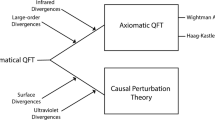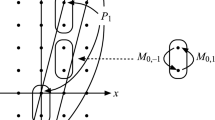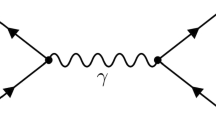Abstract
We briefly review the uniqueness method, which is a powerful technique for calculating multiloop Feynman diagrams in theories with conformal symmetries. We use the method in the momentum space and show its effectiveness in calculating a two-loop massless propagator Feynman diagram with a noninteger index on the central line. We use the obtained result to compute the optical conductivity of graphene at the infrared Lorentz-invariant fixed point. We analyze the effect of counterterms and compare with the nonrelativistic limit.
Similar content being viewed by others
References
A. N. Vasil’ev, Yu. M. Pis’mak, and Yu. R. Khonkonen, “1/n Expansion: Calculation of the exponents η and v in the order 1/n2 for arbitrary number,” Theor. Math. Phys., 47, 465–475 (1981).
K. G. Chetyrkin and F. V. Tkachov, “Integration by parts: The algorithm to calculate ß-functions in 4 loops,” Nucl. Phys. B, 192, 159–204 (1981)
F. V. Tkachov, “A theorem on analytical calculability of 4-loop renormalization group functions,” Phys. Lett. B, 100, 65–68 (1981).
S. Laporta, “High-precision calculation of multiloop Feynman integrals by difference equations,” Internat. J. Modern Phys. A, 15, 5087–5159 (2000).
K. G. Chetyrkin, A. L. Kataev, and F. V. Tkachov, “New approach to evaluation of multiloop Feynman integrals: The Gegenbauer polynomial x-space technique,” Nucl. Phys. B, 174, 345–377 (1980).
A. V. Kotikov, “The Gegenbauer polynomial technique: The evaluation of a class of Feynman diagrams,” Phys. Lett. B, 375, 240–248 (1996).
M. D’Eramo, L. Pelitti, and G. Parisi, “Theoretical predictions for critical exponents at the η-point of Bose liquids,” Lett. Nuovo Cimento, 2, 878–880 (1971).
N. I. Usyukina, “Calculation of many-loop diagrams of perturbation theory,” Theor. Math. Phys., 54, 78–81 (1983).
D. I. Kazakov, “Calculation of Feynman diagrams by the ‘Uniqueness’ method,” Theor. Math. Phys., 58, 223–230 (1984).
D. I. Kazakov, “Many-loop calculations: The uniqueness method and functional equations,” Theor. Math. Phys., 62, 84–89 (1985)
D. I. Kazakov, “The method of uniqueness, a new powerful technique for multiloop calculations,” Phys. Lett. B, 133, 406–410 (1983).
D. I. Kazakov, “Analytical methods for multiloop calculations: Two lectures on the method of uniqueness,” Preprint JINR E2-84-410, Joint Inst. Nucl. Res., Dubna (1984).
A. G. Grozin, “Massless two-loop self-energy diagram: Historical review,” Internat. J. Modern Phys. A, 27, 1230018 (2012).
D. J. Broadhurst, “Exploiting the 1, 440-fold symmetry of the master two-loop diagram,” Z. Phys. C: Part. Fields, 32, 249–253 (1986).
D. T. Barfoot and D. J. Broadhurst, “Z2×S6 symmetry of the two-loop diagram,” Z. Phys. C, 41, 81–85 (1988).
J. A. Gracey, “On the evaluation of massless Feynman diagrams by the method of uniqueness,” Phys. Lett. B, 277, 469–473 (1992).
N. A. Kivel, A. S. Stepanenko, and A. N. Vasil’ev, “On the calculation of 2+e RG functions in the Gross–Neveu model from large-N expansions of critical exponents,” Nucl. Phys. B, 424, 619–627 (1994)
A. N. Vasil’ev, S. E. Derkachev, N. A. Kivel’, and A. S. Stepanenko, “The 1/n expansion in the Gross–Neveu model: Conformal bootstrap calculation of the index η in order 1/n3,” Theor. Math. Phys., 94, 127–136 (1993); arXiv:hep-th/ 9302034v2 (1993).
D. J. Broadhurst, J. A. Gracey, and D. Kreimer, “Beyond the triangle and uniqueness relations: Non-zeta counterterms at large N from positive knots,” Z. Phys. C, 75, 559–574 (1997).
D. J. Broadhurst and A. V. Kotikov, “Compact analytical form for non-zeta terms in critical exponents at order 1/N3,” Phys. Lett. B, 441, 345–353 (1998).
D. J. Broadhurst, “Where do the tedious products of’ s come from?” Nucl. Phys. Proc. Suppl., 116, 432–436 (2003).
I. Bierenbaum and S. Weinzierl, “The massless two-loop two-point function,” Eur. Phys. J. C, 32, 67–78 (2003).
A. V. Kotikov and S. Teber, “Note on an application of the method of uniqueness to reduced quantum electrodynamics,” Phys. Rev. D, 87, 087701 (2013).
A. V. Kotikov and S. Teber, “Two-loop fermion self-energy in reduced quantum electrodynamics and application to the ultrarelativistic limit of graphene,” Phys. Rev. D, 89, 065038 (2014).
S. Teber, “Electromagnetic current correlations in reduced quantum electrodynamics,” Phys. Rev. D, 86, 025005 (2012).
J. González, F. Guinea, and M. A. H. Vozmediano, “Non-Fermi liquid behavior of electrons in the half-filled honeycomb lattice (A renormalization group approach),” Nucl. Phys. B, 424, 595–618 (1994).
D. C. Elias, R. V. Gorbachev, A. S. Mayorov, S. V. Morozov, A. A. Zhukov, P. Blake, L. A. Ponomarenko, I. V. Grigorieva, K. S. Novoselov, F. Guinea, and A. K. Geim, “Dirac cones reshaped by interaction effects in suspended graphene,” Nature Phys., 7, 701–704 (2011).
E. V. Gorbar, V. P. Gusynin, and V. A. Miransky, “Dynamical chiral symmetry breaking on a brane in reduced QED,” Phys. Rev. D, 64, 105028 (2001).
E. C. Marino, “Quantum electrodynamics of particles on a plane and the Chern–Simons theory,” Nucl. Phys. B, 408, 551–564 (1993)
N. Dorey and N. E. Mavromatos, “QED3 and two-dimensional superconductivity without parity violation,” Nucl. Phys. B, 386, 614–680 (1992)
A. Kovner and B. Rosenstein, “Kosterlitz–Thouless mechanism of two-dimensional superconductivity,” Phys. Rev. B, 42, 4748–4751 (1990).
A. W. W. Ludwig, M. P. A. Fisher, R. Shankar, and G. Grinstein, “Integer quantum Hall transition: An alternative approach and exact results,” Phys. Rev. B, 50, 7526–7552 (1994).
E. G. Mishchenko, “Minimal conductivity in graphene: Interaction corrections and ultraviolet anomaly,” Europhys. Lett., 83, 17005 (2008).
I. F. Herbut, V. Juričić, and O. Vafek, “Coulomb interaction, ripples, and the minimal conductivity of graphene,” Phys. Rev. Lett., 100, 046403 (2008)
D. E. Sheehy and J. Schmalian, “Optical transparency of graphene as determined by the fine-structure constant,” Phys. Rev. B, 80, 193411 (2009)
V. Juričić, O. Vafek, and I. F. Herbut, “Conductivity of interacting massless Dirac particles in graphene: Collisionless regime,” Phys. Rev. B, 82, 235402 (2010)
F. de Juan, A. G. Grushin, and M. A. H. Vozmediano, “Renormalization of Coulomb interaction in graphene: Determining observable quantities,” Phys. Rev. B, 82, 125409 (2010)
S. H. Abedinpour, G. Vignale, A. Principi, M. Polini, W-K. Tse, and A. H. MacDonald, “Drude weight, plasmon dispersion, and ac conductivity in doped graphene sheets,” Phys. Rev. B, 84, 045429 (2011)
I. Sodemann and M. M. Fogler, “Interaction corrections to the polarization function of graphene,” Phys. Rev. B, 86, 115408 (2012)
B. Rosenstein, M. Lewkowicz, and T. Maniv, “Chiral anomaly and strength of the electron-electron interaction in graphene,” Phys. Rev. Lett., 110, 066602 (2013)
G. Gazzola, A. L. Cherchiglia, L. A. Cabral, M. C. Nemes, and M. Sampaio, “Conductivity of Coulomb interacting massless Dirac particles in graphene: Regularization-dependent parameters and symmetry constraints,” Europhys. Lett., 104, 27002 (2013);arXiv:1305.6334v3 [cond-mat.mes-hall] (2013)
J. Link, P. P. Orth, D. E. Sheehy, and J. Schmalian, “Universal collisionless transport of graphene,” Phys. Rev. B, 93, 235447 (2016);arXiv:1511.05984v1 [cond-mat.str-el] (2015).
S. Teber and A. V. Kotikov, “Interaction corrections to the minimal conductivity of graphene via dimensional regularization,” Europhys. Lett., 107, 57001 (2014).
A. Giuliani, V. Mastropietro, and M. Porta, “Absence of interaction corrections in the optical conductivity of graphene,” Phys. Rev. B, 83, 195401 (2011).
I. F. Herbut and V. Mastropietro, “Universal conductivity of graphene in the ultrarelativistic regime,” Phys. Rev. B, 87, 205445 (2013).
K. F. Mak, M. Y. Sfeir, Y. Wu, C. H. Lui, J. A. Misewich, and T. F. Heinz, “Measurement of the optical conductivity of graphene,” Phys. Rev. Lett., 101, 196405 (2008)
R. R. Nair, P. Blake, A. N. Grigorenko, K. S. Novoselov, T. J. Booth, T. Stauber, N. M. R. Peres, and A. K. Geim, “Fine structure constant defines visual transparency of graphene,” Science, 320, 1308 (2008).
N. M. R. Peres, “The transport properties of graphene: An introduction,” Rev. Modern Phys., 82, 2673–2700 (2010).
Author information
Authors and Affiliations
Corresponding author
Additional information
The research of A. V. Kotikov was supported by the Russian Foundation for Basic Research (Grant No. 16-02-00790_a).
[The original English version of this paper presented at the conference and submitted to the journal is available at https://arxiv.org/abs/1602.01962.]
Translated from Teoreticheskaya i Matematicheskaya Fizika, Vol. 190, No. 3, pp. 519–532, March, 2017.
Rights and permissions
About this article
Cite this article
Teber, S., Kotikov, A.V. The method of uniqueness and the optical conductivity of graphene: New application of a powerful technique for multiloop calculations. Theor Math Phys 190, 446–457 (2017). https://doi.org/10.1134/S004057791703014X
Published:
Issue Date:
DOI: https://doi.org/10.1134/S004057791703014X




